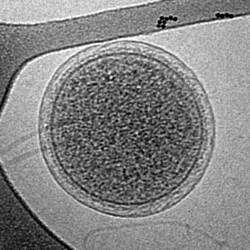Biology:Parvarchaeota
| Parvarchaeota | |
|---|---|

| |
| Parvarchaeum acidiphilum | |
| Scientific classification | |
| Domain: | |
| Kingdom: | |
| Superphylum: | |
| Phylum: | "Parvarchaeota" Rinke et al. 2013
|
| Class: | "Parvarchaeia"
|
| Order: | "Parvarchaeales" Rinke et al. 2020
|
| Families | |
| |
Parvarchaeota is a phylum of archaea belonging to the DPANN archaea. They have been discovered in acid mine drainage waters and later in marine sediments. The cells of these organisms are extremely small consistent with small genomes. Metagenomic techniques allow obtaining genomic sequences from non-cultured organisms, which were applied to determine this phylum.[1]
The type species is Candidatus Parvarchaeum acidiphilum. They have very small cells, around 400-500 nm, and reduced genomes made up of about 1000 genes. A similar-sized archaea that has been found in the same acidic environments is Candidatus Microarcheum, from the phylum Micrarchaeota.[1][2]
According to the phylogenetic trees Parvarchaeota may be a sister group of Thermoplasmata within Euryarchaeota[3] or belong to DPANN,[1] although it has also been suggested that all the DPANN archaea belong phylogenetically to Euryarchaeota.[3][4]
Taxonomy
The currently accepted taxonomy is based on the List of Prokaryotic names with Standing in Nomenclature (LPSN)[5] and National Center for Biotechnology Information (NCBI).[6]
- Family "Acidifodinimicrobiaceae" Luo et al. 2020
- Genus "Candidatus Acidifodinimicrobium" Luo et al. 2020
- "Ca. A. mancum" Luo et al. 2020
- Genus "Candidatus Acidifodinimicrobium" Luo et al. 2020
- Family "Parvarchaeaceae" Rinke et al. 2020
- Genus "Candidatus Parvarchaeum" Baker et al. 2010
- "Ca. P. acidiphilum" Baker et al. 2010
- "Ca. P. paracidiphilum" corrig. Baker et al. 2010
- Genus "Candidatus Parvarchaeum" Baker et al. 2010
See also
References
- ↑ 1.0 1.1 1.2 Rinke C, Schwientek P, Sczyrba A, Ivanova NN, Anderson IJ, Cheng JF, Darling A, Malfatti S, Swan BK, Gies EA, Dodsworth JA, Hedlund BP, Tsiamis G, Sievert SM, Liu WT, Eisen JA, Hallam SJ, Kyrpides NC, Stepanauskas R, Rubin EM, Hugenholtz P, Woyke T (July 25, 2013). "Insights into the phylogeny and coding potential of microbial dark matter". Nature 499, 431–437 (2013) (7459): 431–437. doi:10.1038/nature12352. PMID 23851394. Bibcode: 2013Natur.499..431R.
- ↑ Brett J. Baker, Gregory J. Dick. Omic, Approaches in Microbial Ecology:Charting the Unknown Analysis of wholecommunity sequence data is unveiling the diversity and function of specific microbial groups within uncultured phyla and across entire microbial ecosystems. Academia.edu.
- ↑ 3.0 3.1 Petitjean, C.; Deschamps, P.; López-García, P.; Moreira, D. (2014). "Rooting the domain Archaea by phylogenomic analysis supports the foundation of the new kingdom Proteoarchaeota". Genome Biol. Evol. 7 (1): 191–204. doi:10.1093/gbe/evu274. PMID 25527841.
- ↑ Cavalier-Smith, Thomas; Chao, Ema E-Yung (2020). "Multidomain ribosomal protein trees and the planctobacterial origin of neomura (Eukaryotes, archaebacteria)". Protoplasma 257 (3): 621–753. doi:10.1007/s00709-019-01442-7. PMID 31900730.
- ↑ J.P. Euzéby. "Parvarchaeota". List of Prokaryotic names with Standing in Nomenclature (LPSN). https://lpsn.dsmz.de/phylum/parvarchaeota.
- ↑ Sayers. "Parvarchaeota". National Center for Biotechnology Information (NCBI) taxonomy database. https://www.ncbi.nlm.nih.gov/Taxonomy/Browser/wwwtax.cgi?mode=Tree&id=1462422&lvl=3&lin=f&keep=1&srchmode=1&unlock. Retrieved 2021-03-20.
Wikidata ☰ Q25508584 entry

